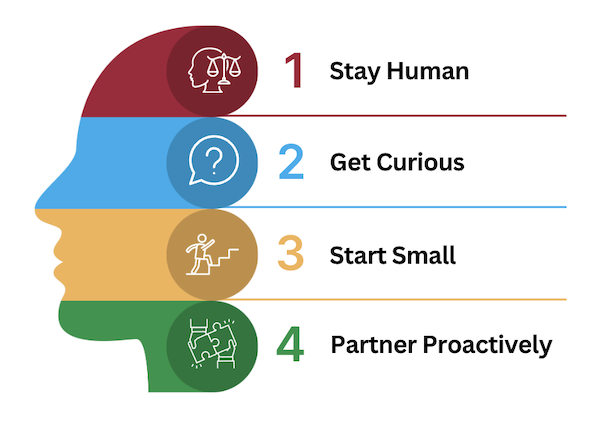In this article, Juniper Networks shares two practical GenAI use cases in Finance that redefine finance...

The AI boom is not on the horizon — it is already here. However, it is not the dystopian automation wave that replaces humans; it is a powerful toolkit that can elevate how FP&A teams drive business impact when paired with human judgment.
For over a decade, companies have used forms of AI in tandem with human expertise. Whether it is predictive analytics for demand forecasting or churn analysis in marketing, the winning formula has been the same: machines identify the patterns, but people make the calls. As FP&A professionals, we now stand at a similar crossroads — called to integrate new tools while sharpening our role as interpreters, advisors, and strategic thinkers.
Brands such as Netflix, Walmart, Amazon, and StitchFix have been at the forefront of being the best-in-class in combining AI technology and human expertise. When I joined StitchFix in 2014 as employee 72, the company's innovative use of algorithms and systems was completely new to me. Prior to joining them, I worked for large public companies: Gap, Williams-Sonoma, and Shutterfly, where the biggest innovation was using Hyperion Essbase. At StitchFix, their proprietary platform was able to codify style features of each item of clothing and accessory in their warehouse and use an algorithm to predict what types of items customers would potentially buy, allowing the human stylist team (and us employees sometimes) to use their judgement and send the customer what we thought they would like based on their Pinterest boards and comments to us.
In 2014, this was novel, but just a mere 11 years later, this type of marriage became the norm. While this sort of innovation has become normalised in the last decade, FP&A has also seen its fair share of innovation, and how we manage reporting and analysis in our day-to-day roles has evolved with the introduction of new technologies far more complex than simple reporting cubes.
The Finance and FP&A functions have always evolved alongside startup and industry innovation. From Excel's launch in 1985 to ERP systems in the '90s, BI tools in the 2000s, and cloud FP&A platforms in the 2010s, we've consistently seen promises of "the next big thing". Yet today, most FP&A teams still rely heavily on Excel. Excel remains the predominant planning application, used by 52% of organisations in 2024. Modern cloud-based planning platforms are the next most utilised tool, at 18%, representing a slight decrease from 20% of organisations in 2022. [1]
Excel is our warm, comfy, weighted blanket. We know what to expect when it works well and when it doesn't. Who remembers all the times Excel crashed and we lost all of our hard work, and the panic we still feel when it crashes, and we don't fully trust that it's autosaved or will be able to restore our spreadsheets? However, Excel has improved over the years, adding more functionality, better file restoration practices, and new functions that don't require knowing VBA. With Excel, we feel in control. It's a technology that we understand and know how to manipulate easily. However, as much as we rely on Excel, it does not make decisions for us, does not predict the weather, and certainly doesn't have all the context needed to run a successful multinational company.
The reality? Tools don't transform teams — people do.
And just like innovations in Excel, the overall landscape of Fintech tools has also evolved. And it will continue to evolve, and as Finance and FP&A professionals, we must be ready for this latest evolution. So what will this mean for us?
How Will AI Help FP&A Evolve?
As a runner, I use technology to help me prepare for my races, whether it's my wearables or generative AI, to help me create my training plan. I have used AI in a variety of ways. Despite my active use of this new technology, I know that AI won't run the race for me, but it can help me choose the best course, avoid hazards, and accelerate where it counts. So, how will AI help the FP&A and Finance functions evolve? Here are some key shifts:
- From Reporting to Recommending: Monthly decks can be drafted by AI, freeing you to refine the story behind the numbers.
- From Sifting to Strategising: AI can analyse massive datasets in seconds — think real-time tariff impact analysis or pricing optimisation.
- From Manual to Meaningful: Automating reconciliations, pulling data, and building base reports clears space for scenario planning, what-if modelling, and agile decision-making.
For example, with the current administration's trade wars and with tariffs changing by the day and sometimes by the hour, AI will help companies be able to analyse the impacts of changes in tariffs in real time, helping us find quick solutions and make production changes that will not result in long lead times and lost profit margin. We will be able to be more nimble and truly reactive in a data-driven way compared to simply making gut decisions.
How to Get Started with AI in FP&A
For a function that has been slower to evolve with technology, how can we ensure that we are not left behind during this AI boom?
The best time to prepare was yesterday. The next best time is now. Here is how to start:
- Stay Human: Judgment matters. AI needs interpreters, not just operators.
- Get Curious: Explore tools, take the sales call, and ask for a demo.
- Start Small: Automate a single report. Try AI-driven analysis in one area.
- Partner Proactively: Collaborate with business leaders to identify pain points and co-create solutions.

Figure 1. How to Get Started with AI in FP&A
But most importantly, don't over-index on AI's capabilities. Most recently, my husband used AI to analyse his blood work and give him suggestions on how to improve his biomarkers. AI made judgements about his numbers and provided insights and recommendations. However, when we sat down together to discuss them, I very quickly realised that his AI tool had misunderstood how a particular test was presented. The results were binary, above or below the target, but AI didn't know this and decided the result was bad when, indeed, it was not. Its recommendations were all focused on this incorrectly classified "bad result." And so, if it were not for my analysis and judgement, my husband would have made unnecessary and even detrimental lifestyle changes.
Final Thought: Insight, Judgment, and Impact
AI in FP&A is not about replacement — it is about augmentation. The future belongs to those who can blend data, intuition, and storytelling. As we ride this wave, let's remember that the tools will keep changing, but the real value lies in how we use them to create insight, influence decisions, and drive impact.
Source:
Subscribe to
FP&A Trends Digest

We will regularly update you on the latest trends and developments in FP&A. Take the opportunity to have articles written by finance thought leaders delivered directly to your inbox; watch compelling webinars; connect with like-minded professionals; and become a part of our global community.







